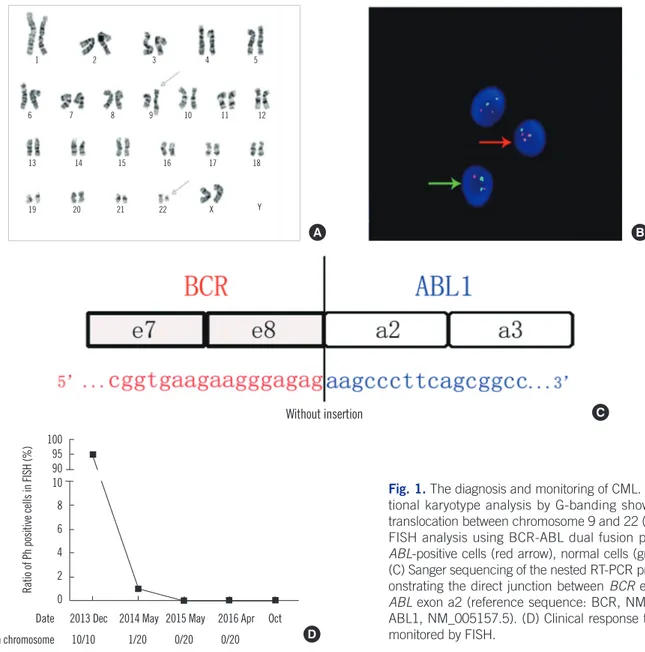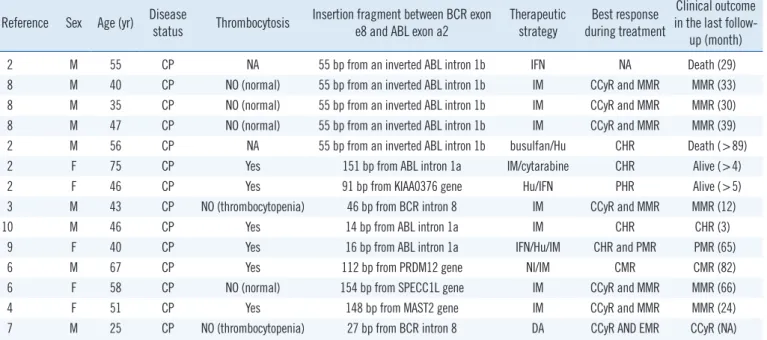ISSN 2234-3806 • eISSN 2234-3814
https://doi.org/10.3343/alm.2018.38.2.169 www.annlabmed.org 169
Ann Lab Med 2018;38:169-171
https://doi.org/10.3343/alm.2018.38.2.169
Letter to the Editor
Diagnostic Hematology
A Novel e8a2BCR-ABL1 Fusion Transcript without Insertion Sequence in a Patient with Chronic Myeloid Leukemia
Caibao Jin, M.D., Xiaojian Zhu, Ph.D., Min Xiao, M.D., Songya Liu, M.D., Xian Liu, M.D., Jingjing Liu, M.D., Xiuwen Xu, M.D., Shujuan Yi, M.D., and Li Meng, M.D.
Department of Hematology, Tongji Hospital, Tongji Medical College, Huazhong University of Science andTechnology, China
Dear Editor,
Chronic myeloid leukemia (CML) is a clonal hematopoietic stem cell disorder characterized by a reciprocal translocation between the long arms of chromosomes 9 and 22, resulting in the forma- tion of a Philadelphia (Ph) chromosome. Most chimeric BCR- ABL1 fusion transcripts are e13a2(b2a2) or e14a2(b3a2), en- coding a 210-kDa protein, p210, but some are a e1a2 transcript or e19a2 transcript encoding a 190-kDa protein or a 230-kDa protein, respectively [1]. Furthermore, some patients harbor rarer atypical transcript types such as e1a3, e6a2, e8a2, and e13a3. In addition, BCR-ABL1 transcripts have been reported to correlate significantly with the prognosis of CML patients. We retrospectively studied a CML patient with a variant BCR-ABL1 fu- sion transcript with no insertion between BCRexon8 and ABLexon2, to elucidate clinical characteristics of the rare e8a2 transcript CML.
The study was approved by the Human Research Ethics Com- mittee of Wuhan Tongji hospital, Wuhan, China. Written informed consent was obtained from the patient. A 47-year-old woman- was referred to Tongji Hospital in December 2013. Peripheral blood analysis revealed a white blood cell count of 124×109/L (82.7% neutrophils, 7.2% lymphocytes, 5.9% monocytes, 3.0%
eosinophils, and 1.2% basophils); platelet count of 613×109/L;
and hemoglobin level of 10.8 g/dL. The patient showed typical characteristics indicative of splenomegaly. The bone marrow smear indicated an abnormal cell composition including 4%
myeloblasts. G-banding karyotype analysis showed 46, XX, t (9;22)(q34;q11) in all 10 analyzed metaphase cells (Fig. 1A).
FISH analysis revealed Ph-positive cells with one green BCR signal, one red ABL signal, and two yellow BCR-ABL fusion sig- nals, which were present in 95% of 200 interphase cells counted (Fig. 1B). Nevertheless, we failed to detect typical BCR-ABL1 transcripts such as e13a2 or e14a2 by qualitative RT-PCR. Sub- sequently, Sanger sequencing of complementary DNA revealed the e8a2-type fusion transcript (Fig. 1C). Accordingly, the pa- tient was diagnosed as having CML in the chronic phase.There- fore, imported imatinib (400 mg, po, qd) was administered. Af- ter two weeks, the imported imatinib was replaced by domestic imatinib (400 mg, po, qd) because of the high cost of the for- mer. At the request of the patient, the cytogenetic response was measured irregularly using FISH rather than by performing mo- lecular monitoring using real-time quantitative PCR (RTqPCR).
Positive cells were undetectable after 17 months of treatment (Fig. 1D).
It is widely acknowledged that the direct junction between BCR exon e8 and ABL exon e2 fails to encode the chimeric oncogenic
Received: February 19, 2017 Revision received: May 26, 2017 Accepted: September 25, 2017 Corresponding author: Li Meng
Department of Hematology, Tongji Hospital, Tongji Medical College, Huazhong University of Science andTechnology, Wuhan 430030, P. R. China Tel: +86-27-83662661, Fax: +86-27-83662640
E-mail: mengli19@hotmail.com
© Korean Society for Laboratory Medicine.
This is an Open Access article distributed under the terms of the Creative Commons Attribution Non-Commercial License (http://creativecommons.org/licenses/by-nc/4.0) which permits unrestricted non-commercial use, distribution, and reproduction in any medium, provided the original work is properly cited.
1 / 1 CROSSMARK_logo_3_Test
2017-03-16 https://crossmark-cdn.crossref.org/widget/v2.0/logos/CROSSMARK_Color_square.svg
Jin C, et al.
e8a2 without insertion sequence
170 www.annlabmed.org https://doi.org/10.3343/alm.2018.38.2.169 protein owing to the presence of a premature stop codon (UAG)
at position 7 after the fusion locus [2, 3]. Nevertheless, insertion of certain sequences could lead to the generation of an in-frame e8a2BCR-ABL1 transcript. In the 14 cases reported previously, insertion sequences from ABL intron 1b were identified in five cases; those from ABL intron 1a in three cases; those from BCR intron 8 in two cases; and those from another definite gene such as PRDM12, SPECC1L, or MAST2, in four cases [4-6]. Interes- tingly, in our case, sequencing analysis revealed that the BCR- ABL1 transcript was derived from a direct combination of BCR exon e8 to ABL exon e2, without any insertion between them.
Moreover, this junction subtype of could indeed encode the on- cogenic protein resulting in occurrence of CML. Furthermore, the number of bases in this insertion sequence contained three
multiples of triplet bases [7]. Perhaps in simply considering the advent of the stop codon after the fusion contributing to the halt of normal translation of the BCR-ABL1 transcript, the previous reports misinterpreted the accurate coding sequence in the open reading frame of the fusion transcript.
According to the analysis of all cases, thrombocytosis could not predict the prognosis of patients. The insertion segment de- rived from particular functional genes including PRDM12, SPE- CC1L, or MAST2 demonstrated no association with poor molec- ular response. Additionally, tyrosine kinase inhibitors (TKIs) could effectively treat CML patients with the e8a2 transcript (Ta- ble 1). Just as in our case, the patient achieved complete cyto- genetic response. Moreover, in an unique reported case where imatinib treatment was withdrawn after four years of constant
Fig. 1. The diagnosis and monitoring of CML. (A) Conven- tional karyotype analysis by G-banding showing typical translocation between chromosome 9 and 22 (arrows). (B) FISH analysis using BCR-ABL dual fusion probe. BCR- ABL-positive cells (red arrow), normal cells (green arrow).
(C) Sanger sequencing of the nested RT-PCR product dem- onstrating the direct junction between BCR exon e8 and ABL exon a2 (reference sequence: BCR, NM_004327.3;
ABL1, NM_005157.5). (D) Clinical response to treatment monitored by FISH.
A B
D 100
95 90 10 8 6 4 2 0
Date 2013 Dec 2014 May 2015 May 2016 Apr Oct Ph chromosome 10/10 1/20 0/20 0/20
Ratio of Ph positive cells in FISH (%)
Without insertion C
1 2 3 4 5
6 7 8 9 10 11 12
13 14 15 16 17 18
19 20 21 22 X Y
Jin C, et al.
e8a2 without insertion sequence
https://doi.org/10.3343/alm.2018.38.2.169 www.annlabmed.org 171
complete molecular remission, the e8a2 transcript became de- tectable after three months and reverted to an undetectable sta- tus again four months after resumption of imatinib treatment.
It is recommended that RT-qPCR be utilized to monitor the molecular level precisely. TKIs have been demonstrated to be effective in the treatment of e8a2-positive patients. However, a larger number of CML patients with the e8a2 transcript are needed to study the clinical features and prognosis.
Authors’ Disclosures of Potential Conflicts of Interest
No potential conflicts of interest relevant to this article were re- ported.
Acknowledgments
This study was supported by a grant from the National Natural Science Foundation of China (Grant Number-81272422).
REFERENCES
1. Jain P, Kantarjian H, Patel KP, Gonzalez GN, Luthra R, KanagalShama- nna R, et al. Impact of BCR-ABL transcript type on outcome in patients with chronic-phase CML treated with tyrosine kinase inhibitors. Blood 2016;127:1269-75.
2. Demehri S, Paschka P, Schultheis B, Lange T, Koizumi T, Sugimoto T, et al. e8a2 BCR-ABL: more frequent than other atypical BCR-ABL vari- ants? Leukemia 2005;19:681-4.
3. Tchirkov A, Couderc JL, Périssel B, Goumy C, Regnier A, Uhrhammer N, et al. Major molecular response to imatinib in a patient with chronic myeloid leukemia expressing a novel form of e8a2 BCR-ABL transcript.
Leukemia 2006;20:167-8.
4. Riva E, Manrique Arechavaleta G, De Almeida C, Costa V, Fernandez Del Campo M, Ifran González S, et al. A novel e8a2 BCR-ABL1 fusion with insertion of MAST2 exon 2 in a four-way translocation t (1;17;9;22) (p35;q24;q44;q11) in a patient with chronic myeloid leukemia. Leuk Lymphoma 2015;57:203-5.
5. Reid AG and Nacheva EP. A potential role for PRDM12 in the pathogen- esis of chronic myeloid leukaemia with derivative chromosome 9 dele- tion. Leukemia 2004;18:178-80.
6. Huet S, Dulucq S, Chauveau A, Ménard A, Chomel JC, Maisonneuve H, et al. Molecular characterization and follow-up of five CML patients with new BCR-ABL1 fusion transcripts. Genes Chromosomes Cancer 2015;
54:595-605.
7. Chen L, Wu Y, You Y, Xiao M, Yao Y, Li W. A novel e8a2 BCR-ABL1 in- tronic fusion through insertion of a chromosome 22 BCR gene fragment into chromosome 9 in an atypical Philadelphia (Ph) chromosome chronic myeloid leukemia patient. Leuk Lymphoma 2016;57:2930-3.
8. Cayuela JM, Rousselot P, Nicolini F, Espinouse D, Ollagnier C, Bui-Thi MH, et al. Identification of a rare e8a2BCR-ABL fusion gene in three novel chronic myeloid leukemia patients treated with imatinib. Leuke- mia 2005;19:2234-6.
9. Qin YZ, Jiang B, Jiang Q, Zhang Y, Jiang H, Li JL, et al. Imatinib mesyl- ate resistance in a chronic myeloid leukemia patient with a novel e8a2 BCR-ABL transcript variant. Acta Haematol 2008;120:146-9.
10. Park IJ, Lim YA, Lee WG, Park JS, Kim HC, Lee HJ, et al. A case of chro- nic myelogenous leukemia with e8a2 fusion transcript. Cancer Genet Cytogenet 2008;185:106-8.
Table 1. Summary of CML cases with e8a2 BCR/ABL1 fusion transcript Reference Sex Age (yr) Disease
status Thrombocytosis Insertion fragment between BCR exon
e8 and ABL exon a2 Therapeutic
strategy Best response during treatment
Clinical outcome in the last follow-
up (month)
2 M 55 CP NA 55 bp from an inverted ABL intron 1b IFN NA Death (29)
8 M 40 CP NO (normal) 55 bp from an inverted ABL intron 1b IM CCyR and MMR MMR (33)
8 M 35 CP NO (normal) 55 bp from an inverted ABL intron 1b IM CCyR and MMR MMR (30)
8 M 47 CP NO (normal) 55 bp from an inverted ABL intron 1b IM CCyR and MMR MMR (39)
2 M 56 CP NA 55 bp from an inverted ABL intron 1b busulfan/Hu CHR Death (>89)
2 F 75 CP Yes 151 bp from ABL intron 1a IM/cytarabine CHR Alive (>4)
2 F 46 CP Yes 91 bp from KIAA0376 gene Hu/IFN PHR Alive (>5)
3 M 43 CP NO (thrombocytopenia) 46 bp from BCR intron 8 IM CCyR and MMR MMR (12)
10 M 46 CP Yes 14 bp from ABL intron 1a IM CHR CHR (3)
9 F 40 CP Yes 16 bp from ABL intron 1a IFN/Hu/IM CHR and PMR PMR (65)
6 M 67 CP Yes 112 bp from PRDM12 gene NI/IM CMR CMR (82)
6 F 58 CP NO (normal) 154 bp from SPECC1L gene IM CCyR and MMR MMR (66)
4 F 51 CP Yes 148 bp from MAST2 gene IM CCyR and MMR MMR (24)
7 M 25 CP NO (thrombocytopenia) 27 bp from BCR intron 8 DA CCyR AND EMR CCyR (NA)
Abbreviations: M, male; F, female; CP, chronic phase; IFN, interferon-alpha; Hu, hydroxyurea; IM, imatinib; DA, dasatinib; CHR, complete hematological re- sponse; CCyR, complete cytogenetic response; PMR, partial molecular response; MMR, major molecular response; CMR, complete molecular response; NA, not available.

